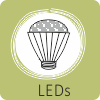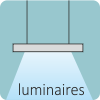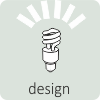HID technology uses gas discharge to generate optical radiations in form of single spectral lines. These spectral lines may be used directly or via conversion by phosphors. Depending on the spectral lines, different light colours are generated via these discharge lamps. A magnetic or electric ballast is critical to complete the circuit of the discharge lamps and ensure stable operations. The process of light generations produces significant amount of heat which results into thermal loading on the discharge tube wall raising the temperature to nearly 1000 degree Celsius.
Mercury Vapour
Light is produced in a mercury lamp with electric current through mercury vapour. A discharge in mercury produces light in 5 visible wavelength and other wavelengths are converted to visible by phosphor layers at the outer bulb. The efficacies of these lamps are a range of 40 – 60 lm/W, CRI between 40 – 60 and CCT at nearly 4000 K.Mercury lamps have been banned any few countries due their toxic content and heat intensive operations
Metal Halide
Mercury vapour lamp emits spectral lines in five wavelength only resulting in limited colours. To increase the CRI of mercury high pressure lamp together with efficacy, mixtures of metal components are added to the discharge tube to emit respective line spectra. This process results in variety of light colours. Metal halides (compounds with iodine and bromine) are more suitable and stable compound for the process. The luminous efficacy, CCT, and CRI of metal halide ranges from 50 – 100 lm/ W, 3000 – 6000 K, 70 – 90 respectively. The average lamp life ranges from 4000 – 8000 hours.
Key advantages:
- Better luminous efficacy compared to mercury vapour
- Better CRI compared to mercury vapour
Key disadvantages:
- Relatively expensive
- Starting and re-staring time is 2 – 4 minutes
Sodium Lamps
Sodium lamp uses sodium vapour to produce golden-yellowish light emission. CRI value of these lamps are very low (nearly 20) limiting the application of the product but the high luminous efficacy made it suitable for street and area lighting for decades. The luminous efficacy, CCT, and lamp life of sodium lamps ranges from 80 – 100 lm/ W, 1800 – 2200 K, 10,000 – 12,000 hours respectively. Methods to improve the CRI are available in the market at the cost of lower efficacy.
Key advantages:
- High luminous efficacy
- Long lamp life
Key disadvantages:
- Low CCT and CRI
- Starting and re-starting time is 2 – 5 minutes














